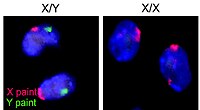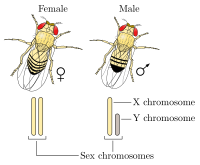XY sex-determination system
| Part of a series on |
| Sex |
|---|
 |
| Biological terms |
| Sexual reproduction |
| Sexuality |
| Sexual system |

The XY sex-determination system is a sex-determination system present in many mammals, including humans, some insects (Drosophila), some snakes, some fish (guppies), and some plants (Ginkgo tree).
In this system, the sex of an individual usually is determined by a pair of sex chromosomes. Typically, females have two of the same kind of sex chromosome (XX), and are called the homogametic sex. Males typically have two different kinds of sex chromosomes (XY), and are called the heterogametic sex.[1] In humans, the presence of the Y chromosome is responsible for triggering male development; in the absence of the Y chromosome, the fetus will undergo female development, except with various exceptions such as individuals with Swyer syndrome, that have XY chromosomes and a female phenotype, and de la Chapelle Syndrome, that have XX chromosomes and a male phenotype, however these exceptions are rare. In some instances, a seemingly normal female with a vagina, cervix, and ovaries has XY chromosomes, but the SRY gene has been shut down.[2][3] In most species with XY sex determination, an organism must have at least one X chromosome in order to survive.[4][5]
The XY system contrasts in several ways with the ZW sex-determination system found in birds, some insects, many reptiles, and various other animals, in which the heterogametic sex is female.
A temperature-dependent sex determination system is found in some reptiles and fish.
Mechanisms
[edit]All animals have a set of DNA coding for genes present on chromosomes. In humans, most mammals, and some other species, two of the chromosomes, called the X chromosome and Y chromosome, code for sex. In these species, one or more genes are present on their Y chromosome that determine maleness. In this process, an X chromosome and a Y chromosome act to determine the sex of offspring, often due to genes located on the Y chromosome that code for maleness. Offspring have two sex chromosomes: an offspring with two X chromosomes (XX) will develop female characteristics, and an offspring with an X and a Y chromosome (XY) will develop male characteristics.
Mammals
[edit]In most mammals, sex is determined by presence of the Y chromosome. This makes individuals with XXY and XYY karyotypes males, and individuals with X and XXX karyotypes females.[1]
In the 1930s, Alfred Jost determined that the presence of testosterone was required for Wolffian duct development in the male rabbit.[6]
SRY is a sex-determining gene on the Y chromosome in the therians (placental mammals and marsupials).[7] Non-human mammals use several genes on the Y chromosome.[citation needed]
Not all male-specific genes are located on the Y chromosome. The platypus, a monotreme, use five pairs of different XY chromosomes with six groups of male-linked genes, AMH being the master switch.[8]
Humans
[edit]A single gene (SRY) present on the Y chromosome acts as a signal to set the developmental pathway towards maleness. Presence of this gene starts off the process of virilization. This and other factors result in the sex differences in humans.[9] The cells in females, with two X chromosomes, undergo X-inactivation, in which one of the two X chromosomes is inactivated. The inactivated X chromosome remains within a cell as a Barr body.
Other animals
[edit]Some species of turtles have convergently evolved XY sex determination systems, specifically those in Chelidae and Staurotypinae.[10]
Other species (including most Drosophila species) use the presence of two X chromosomes to determine femaleness: one X chromosome gives putative maleness, but the presence of Y chromosome genes is required for normal male development. In the fruit fly individuals with XY are male and individuals with XX are female; however, individuals with XXY or XXX can also be female, and individuals with X can be males.[11]
Plants
[edit]Angiosperms
[edit]While very few species of dioecious angiosperm have XY sex determination, making up less than 5% of all species, the sheer diversity of angiosperms means that the total number of species with XY sex determination is actually quite high, estimated to be at around 13,000 species. Molecular and evolutionary studies also show that XY sex determination has evolved independently many times in upwards of 175 unique families, with a recent study suggesting its evolution has independently occurred hundreds to thousands of times.[12]
Many economically important crops are known to have an XY system of sex determination, including kiwifruit,[13] asparagus,[14] grapes[15] and date palms.[16]
Gymnosperms
[edit]In sharp contrast to angiosperms, approximately 65% of gymnosperms are dioecious. Some families which contain members that are known to have a XY system of sex determination include the cycad families Cycadaceae and Zamiaceae, Ginkgoaceae, Gnetaceae and Podocarpaceae.[17]
Other systems
[edit]Whilst XY sex determination is the most familiar, since it is the system that humans use, there are a range of alternative systems found in nature. The inverse of the XY system (called ZW to distinguish it) is used in birds and many insects, in which it is the females that are heterogametic (ZW), while males are homogametic (ZZ).[18]
Many insects of the order Hymenoptera instead have a haplo-diploid system, where the females are full diploids (with all chromosomes appearing in pairs) but males are haploid (having just one copy of all chromosomes). Some other insects have the X0 sex-determination system, where just the sex-determining chromosome varies in ploidy (XX in females but X in males), while all other chromosomes appear in pairs in both sexes.[19]
Influences
[edit]Genetic
[edit]
In an interview for the Rediscovering Biology website,[20] researcher Eric Vilain described how the paradigm changed since the discovery of the SRY gene:
For a long time we thought that SRY would activate a cascade of male genes. It turns out that the sex determination pathway is probably more complicated and SRY may in fact inhibit some anti-male genes.
The idea is instead of having a simplistic mechanism by which you have pro-male genes going all the way to make a male, in fact there is a solid balance between pro-male genes and anti-male genes and if there is a little too much of anti-male genes, there may be a female born and if there is a little too much of pro-male genes then there will be a male born.
We [are] entering this new era in molecular biology of sex determination where it's a more subtle dosage of genes, some pro-males, some pro-females, some anti-males, some anti-females that all interplay with each other rather than a simple linear pathway of genes going one after the other, which makes it very fascinating but very complicated to study.
In an interview by Scientific American in 2007, Vilian was asked: "It sounds as if you are describing a shift from the prevailing view that female development is a default molecular pathway to active pro-male and antimale pathways. Are there also pro-female and antifemale pathways?"[21] He replied:
Modern sex determination started at the end of the 1940s—1947—when the French physiologist Alfred Jost said it's the testis that is determining sex. Having a testis determines maleness, not having a testis determines femaleness. The ovary is not sex-determining. It will not influence the development of the external genitalia. Now in 1959 when the karyotype of Klinefelter [a male who is XXY] and Turner [a female who has one X] syndromes was discovered, it became clear that in humans it was the presence or the absence of the Y chromosome that's sex determining. Because all Klinefelters that have a Y are male, whereas Turners, who have no Y, are females. So it's not a dosage or the number of X's, it's really the presence or absence of the Y. So if you combine those two paradigms, you end up having a molecular basis that's likely to be a factor, a gene, that's a testis-determining factor, and that's the sex-determining gene. So the field based on that is really oriented towards finding testis-determining factors. What we discovered, though, was not just pro-testis determining factors. There are a number of factors that are there, like WNT4, like DAX1, whose function is to counterbalance the male pathway.
In mammals, including humans, the SRY gene triggers the development of non-differentiated gonads into testes rather than ovaries. However, there are cases in which testes can develop in the absence of an SRY gene (see sex reversal). In these cases, the SOX9 gene, involved in the development of testes, can induce their development without the aid of SRY. In the absence of SRY and SOX9, no testes can develop and the path is clear for the development of ovaries. Even so, the absence of the SRY gene or the silencing of the SOX9 gene are not enough to trigger sexual differentiation of a fetus in the female direction. A recent finding suggests that ovary development and maintenance is an active process,[22] regulated by the expression of a "pro-female" gene, FOXL2. In an interview[23] for the TimesOnline edition, study co-author Robin Lovell-Badge explained the significance of the discovery:
We take it for granted that we maintain the sex we are born with, including whether we have testes or ovaries. But this work shows that the activity of a single gene, FOXL2, is all that prevents adult ovary cells turning into cells found in testes.
Implications
[edit]Looking into the genetic determinants of human sex can have wide-ranging consequences. Scientists have been studying different sex determination systems in fruit flies and animal models to attempt an understanding of how the genetics of sexual differentiation can influence biological processes like reproduction, ageing[24] and disease.
Maternal
[edit]In humans and many other species of animals, the father determines the sex of the child. In the XY sex-determination system, the female-provided ovum contributes an X chromosome and the male-provided sperm contributes either an X chromosome or a Y chromosome, resulting in female (XX) or male (XY) offspring, respectively.
Hormone levels in the male parent affect the sex ratio of sperm in humans.[25] Maternal influences also impact which sperm are more likely to achieve conception.
Human ova, like those of other mammals, are covered with a thick translucent layer called the zona pellucida, which the sperm must penetrate to fertilize the egg. Once viewed simply as an impediment to fertilization, recent research indicates the zona pellucida may instead function as a sophisticated biological security system that chemically controls the entry of the sperm into the egg and protects the fertilized egg from additional sperm.[26]
Recent research indicates that human ova may produce a chemical which appears to attract sperm and influence their swimming motion. However, not all sperm are positively impacted; some appear to remain uninfluenced and some actually move away from the egg.[27]
Maternal influences may also be possible that affect sex determination in such a way as to produce fraternal twins equally weighted between one male and one female.[28]
The time at which insemination occurs during the estrus cycle has been found to affect the sex ratio of the offspring of humans, cattle, hamsters, and other mammals.[25] Hormonal and pH conditions within the female reproductive tract vary with time, and this affects the sex ratio of the sperm that reach the egg.[25]
Sex-specific mortality of embryos also occurs.[25]
History
[edit]Ancient ideas on sex determination
[edit]Aristotle believed incorrectly that the sex of an infant is determined by how much heat a man's sperm had during insemination. He wrote:
... the semen of the male differs from the corresponding secretion of the female in that it contains a principle within itself of such a kind as to set up movements also in the embryo and to concoct thoroughly the ultimate nourishment, whereas the secretion of the female contains material alone. If, then, the male element prevails it draws the female element into itself, but if it is prevailed over it changes into the opposite or is destroyed.
Aristotle claimed in error that the male principle was the driver behind sex determination,[29] such that if the male principle was insufficiently expressed during reproduction, the fetus would develop as a female.
20th century genetics
[edit]

Nettie Stevens (working with beetles) and Edmund Beecher Wilson (working with hemiptera) are credited with independently discovering, in 1905, the chromosomal XY sex-determination system in insects: the fact that males have XY sex chromosomes and females have XX sex chromosomes.[30][31][32] In the early 1920s, Theophilus Painter demonstrated that sex in humans (and other mammals) was also determined by the X and Y chromosomes, and the chromosomes that make this determination are carried by the spermatozoa.[33]
The first clues to the existence of a factor that determines the development of testis in mammals came from experiments carried out by Alfred Jost,[34] who castrated embryonic rabbits in utero and noticed that they all acquired a female phenotype.[35]
In 1959, C. E. Ford and his team, in the wake of Jost's experiments, discovered[36] that the Y chromosome was needed for a fetus to develop as male when they examined patients with Turner's syndrome, who grew up as phenotypic females, and found them to be X0 (hemizygous for X and no Y). At the same time, Jacob & Strong described a case of a patient with Klinefelter syndrome (XXY),[37] which implicated the presence of a Y chromosome in development of maleness.[38]
All these observations led to a consensus that a dominant gene that determines testis development (TDF) must exist on the human Y chromosome.[38] The search for this testis-determining factor (TDF) led to Peter Goodfellow's team of scientists[39] in 1990 to discover a region of the Y chromosome that is necessary for the male sex determination, which was named SRY (sex-determining region of the Y chromosome).[38]
See also
[edit]- Sexual differentiation (human)
- Secondary sex characteristic (human)
- Y-chromosomal Adam
- Sex Determination in Silene
- Sex-determination system
- Haplodiploid sex-determination system
- Z0 sex-determination system
- ZW sex-determination system
- Temperature-dependent sex determination
- X chromosome
- Y chromosome
- XY gonadal dysgenesis
References
[edit]- ^ a b Hake L, O'Connor C (2008). "Genetic Mechanisms of Sex Determination". Nature Education. Learn Science at Scitable. 1 (1): 25. Archived from the original on 2021-04-28.
- ^ Callaway E (9 April 2009). "Girl with Y chromosome sheds light on maleness". New Scientist. Retrieved 2023-02-22.
- ^ Biason-Lauber A, Konrad D, Meyer M, DeBeaufort C, Schoenle EJ (May 2009). "Ovaries and female phenotype in a girl with 46,XY karyotype and mutations in the CBX2 gene". American Journal of Human Genetics. 84 (5): 658–663. doi:10.1016/j.ajhg.2009.03.016. PMC 2680992. PMID 19361780.
- ^ Sherwood S (16 January 2014). "Can a Zygote Survive Without an X Sex Chromosome?". Education - Seattle PI. Retrieved 2020-11-08.
- ^ Sherwood S (April 25, 2017). "What Occurs When the Zygote Has One Fewer Chromosome than Usual?". Sciencing. Retrieved 2021-04-29.
- ^ Jost A (August 1970). "Hormonal factors in the sex differentiation of the mammalian foetus". Philosophical Transactions of the Royal Society of London. Series B, Biological Sciences. 259 (828): 119–130. Bibcode:1970RSPTB.259..119J. doi:10.1098/rstb.1970.0052. JSTOR 2417046. PMID 4399057.
- ^ Wallis MC, Waters PD, Graves JA (October 2008). "Sex determination in mammals--before and after the evolution of SRY". Cellular and Molecular Life Sciences. 65 (20): 3182–3195. doi:10.1007/s00018-008-8109-z. PMC 11131626. PMID 18581056. S2CID 31675679.
- ^ Cortez D, Marin R, Toledo-Flores D, Froidevaux L, Liechti A, Waters PD, et al. (April 2014). "Origins and functional evolution of Y chromosomes across mammals" (PDF). Nature. 508 (7497): 488–493. Bibcode:2014Natur.508..488C. doi:10.1038/nature13151. PMID 24759410. S2CID 4462870. Archived (PDF) from the original on Aug 10, 2017.
- ^ Fauci AS, Braunwald E, Kasper DL, Hauser SL, Longo DL, Jameson JL, et al. (2008). Harrison's Principles of Internal Medicine (17th ed.). McGraw-Hill Medical. pp. 2339–2346. ISBN 978-0-07-147693-5.
- ^ Badenhorst D, Stanyon R, Engstrom T, Valenzuela N (April 2013). "A ZZ/ZW microchromosome system in the spiny softshell turtle, Apalone spinifera, reveals an intriguing sex chromosome conservation in Trionychidae". Chromosome Research. 21 (2): 137–147. doi:10.1007/s10577-013-9343-2. PMID 23512312. S2CID 14434440.
- ^ Fusco G, Minelli A (2019-10-10). The Biology of Reproduction. Cambridge University Press. pp. 306–308. ISBN 978-1-108-49985-9.
- ^ Leite Montalvão AP, Kersten B, Fladung M, Müller NA (2021-01-15). "The Diversity and Dynamics of Sex Determination in Dioecious Plants". Frontiers in Plant Science. 11. doi:10.3389/fpls.2020.580488. ISSN 1664-462X. PMC 7843427. PMID 33519840.
- ^ Akagi T, Pilkington SM, Varkonyi-Gasic E, Henry IM, Sugano SS, Sonoda M, et al. (August 2019). "Two Y-chromosome-encoded genes determine sex in kiwifruit". Nature Plants. 5 (8): 801–809. Bibcode:2019NatPl...5..801A. doi:10.1038/s41477-019-0489-6. ISSN 2055-0278. PMID 31383971.
- ^ Harkess A, Huang K, van der Hulst R, Tissen B, Caplan JL, Koppula A, et al. (June 2020). "Sex Determination by Two Y-Linked Genes in Garden Asparagus". The Plant Cell. 32 (6): 1790–1796. doi:10.1105/tpc.19.00859. ISSN 1532-298X. PMC 7268802. PMID 32220850.
- ^ Picq S, Santoni S, Lacombe T, Latreille M, Weber A, Ardisson M, et al. (2014-09-03). "A small XY chromosomal region explains sex determination in wild dioecious V. vinifera and the reversal to hermaphroditism in domesticated grapevines". BMC Plant Biology. 14 (1): 229. doi:10.1186/s12870-014-0229-z. ISSN 1471-2229. PMC 4167142. PMID 25179565.
- ^ Intha N, Chaiprasart P (2018-06-16). "Sex determination in date palm (Phoenix dactylifera L.) by PCR based marker analysis". Scientia Horticulturae. 236: 251–255. Bibcode:2018ScHor.236..251I. doi:10.1016/j.scienta.2018.03.039. ISSN 0304-4238.
- ^ Ohri D, Rastogi S (2020-04-01). "Sex determination in gymnosperms". The Nucleus. 63 (1): 75–80. doi:10.1007/s13237-019-00297-w. ISSN 0976-7975.
- ^ Smith CA, Sinclair AH (February 2004). "Sex determination: insights from the chicken". BioEssays. 26 (2): 120–132. doi:10.1002/bies.10400. PMID 14745830.
- ^ Lee C. "5 Types of Sex Determination in Animals". Knoji Consumer Knowledge. Archived from the original on 5 February 2017. Retrieved 3 May 2018.
- ^ Vilain E. "Rediscovering Biology, Unit 11 - Biology of Sex and Gender, Expert interview transcripts". Annenberg Media. Archived from the original on 2010-08-23.
- ^ Lehrman S. "When a Person Is Neither XX nor XY: A Q&A with Geneticist Eric Vilain". Scientific American. Retrieved 2021-08-08.
- ^ Uhlenhaut NH, Jakob S, Anlag K, Eisenberger T, Sekido R, Kress J, et al. (December 2009). "Somatic sex reprogramming of adult ovaries to testes by FOXL2 ablation". Cell. 139 (6): 1130–1142. doi:10.1016/j.cell.2009.11.021. PMID 20005806.
- ^ Devlin H (December 11, 2009). "Scientists find single 'on-off' gene that can change gender traits". The Times. Archived from the original on 2011-08-14.
- ^ Tower J, Arbeitman M (2009). "The genetics of gender and life span". Journal of Biology. 8 (4): 38. doi:10.1186/jbiol141. PMC 2688912. PMID 19439039.
- ^ a b c d Krackow S (May 1995). "Potential mechanisms for sex ratio adjustment in mammals and birds". Biological Reviews of the Cambridge Philosophical Society. 70 (2): 225–241. doi:10.1111/j.1469-185X.1995.tb01066.x. PMID 7605846. S2CID 27957961.
- ^ Wymelenberg S (1990). "Infertility". Science and Babies. National Academy Press. p. 17. ISBN 978-0-309-04136-2.
- ^ Jones RE, Lopez KH (2006). Human Reproductive Biology (Third ed.). Elsevier. p. 238. ISBN 978-0-12-088465-0.
- ^ Johnson BH. "Familial recurrence of gender-balanced twins" (PDF). Archived from the original (PDF) on October 2, 2015.
- ^ Aristotle (September 2013). De Generatione Animalium [Generation of Animals] (in Latin). Vol. 766B. General Books. pp. 15–17. ISBN 978-1-230-42265-7.
- ^ Brush SG (June 1978). "Nettie M. Stevens and the discovery of sex determination by chromosomes". Isis; an International Review Devoted to the History of Science and Its Cultural Influences. 69 (247): 163–172. doi:10.1086/352001. JSTOR 230427. PMID 389882. S2CID 1919033.
- ^ "Specialized chromosomes determine sex. - Nettie Maria Stevens". DNA from the Beginning. Laurel Hollow, New York: DNA Learning Center, Cold Spring Harbor Laboratory. Archived from the original on 2012-10-01. Retrieved 2016-07-07.
- ^ Heilbron JL, ed. (2003). "Genetics". The Oxford Companion to the History of Modern Science. Oxford University Press. ISBN 978-0-19-511229-0.
- ^ Glass B (1990). "Theophilus Shickel Painter 1889—1969" (PDF). Biographical Memoirs. Vol. 59. Washington DC: National Academy of Sciences. ISBN 978-0-309-04198-0.
- ^ Jost A (1947). "Recherches sur la differenciation sexuelle de l'embryon de lapin" [Research on sexual differentiation of the rabbit embryo]. Archives d'anatomie microscopique et de morphologie expérimentale [Archives of microscopic anatomy and experimental morphology] (in French). 36: 271–315.
- ^ Zhao F, Yao HH (September 2019). "A tale of two tracts: history, current advances, and future directions of research on sexual differentiation of reproductive tracts†". Biology of Reproduction. 101 (3): 602–616. doi:10.1093/biolre/ioz079. PMC 6791057. PMID 31058957.
- ^ Ford CE, Jones KW, Polani PE, De Almeida JC, Briggs JH (April 1959). "A sex-chromosome anomaly in a case of gonadal dysgenesis (Turner's syndrome)". Lancet. 1 (7075): 711–713. doi:10.1016/S0140-6736(59)91893-8. PMID 13642858.
- ^ Jacobs PA, Strong JA (January 1959). "A case of human intersexuality having a possible XXY sex-determining mechanism". Nature. 183 (4657): 302–303. Bibcode:1959Natur.183..302J. doi:10.1038/183302a0. PMID 13632697. S2CID 38349997.
- ^ a b c Schoenwolf GC (2009). "Development of the Urogenital system". Larsen's human embryology (4th ed.). Philadelphia: Churchill Livingstone/Elsevier. pp. 307–9. ISBN 978-0-443-06811-9.
- ^ Sinclair AH, Berta P, Palmer MS, Hawkins JR, Griffiths BL, Smith MJ, et al. (July 1990). "A gene from the human sex-determining region encodes a protein with homology to a conserved DNA-binding motif". Nature. 346 (6281): 240–244. Bibcode:1990Natur.346..240S. doi:10.1038/346240a0. PMID 1695712. S2CID 4364032.
External links
[edit]- Sex Determination and Differentiation
- Can Mammalian Mothers Control the Sex of their Offspring? (KQED Science article on San Diego Zoo research.)
- Maternal Diet and Other Factors Affecting Offspring Sex Ratio: A Review, published in Biology of Reproduction
- Sex Determination and the Maternal Dominance Hypothesis
- Sperm-Ovum Interactions at WikiGenes


